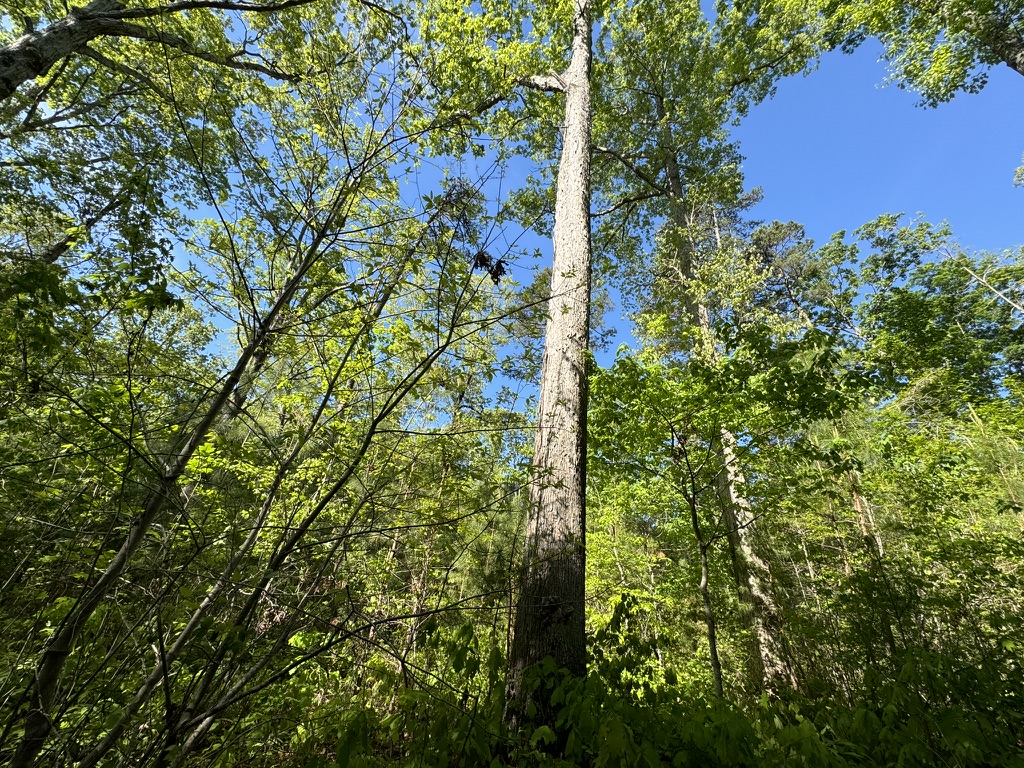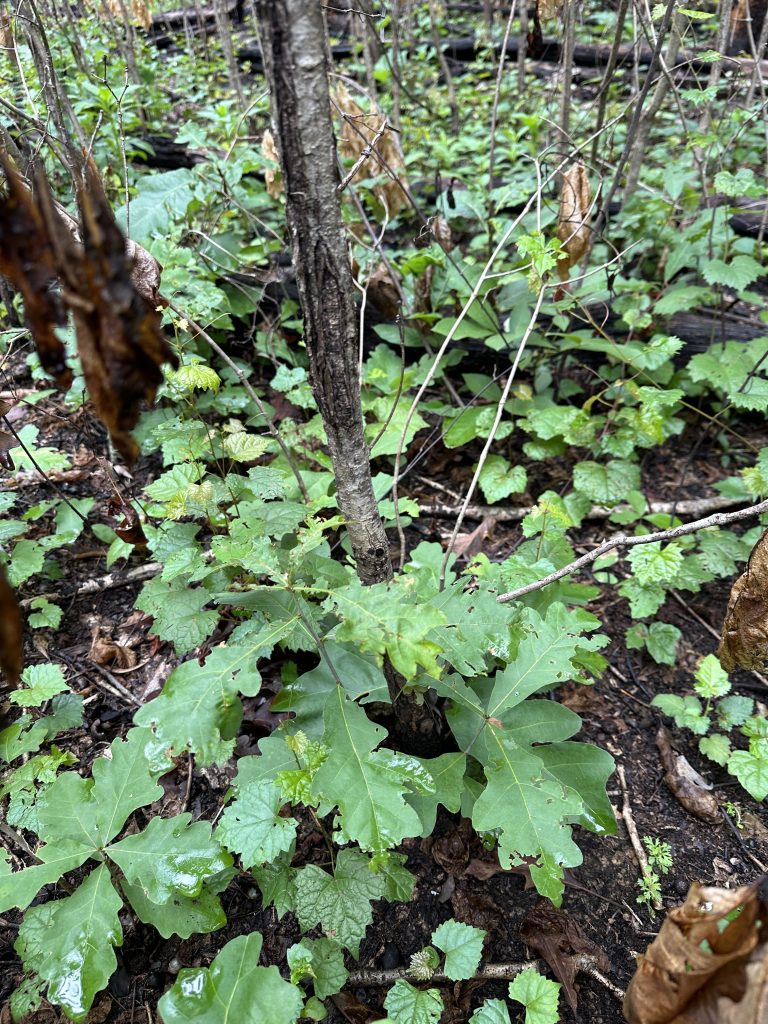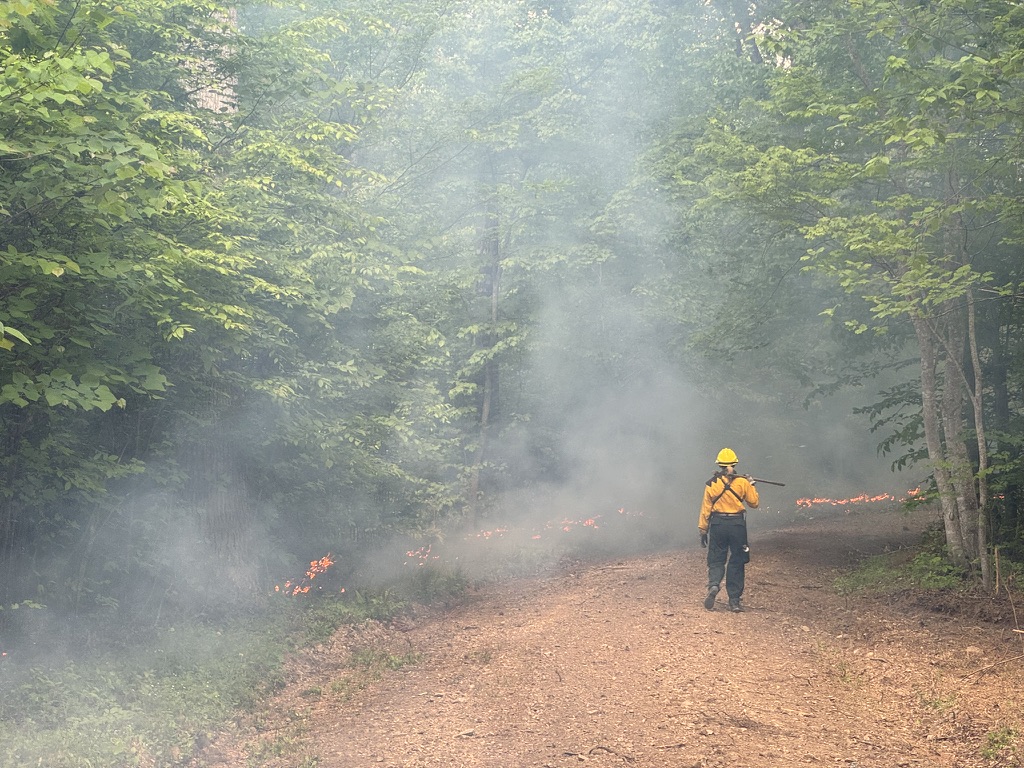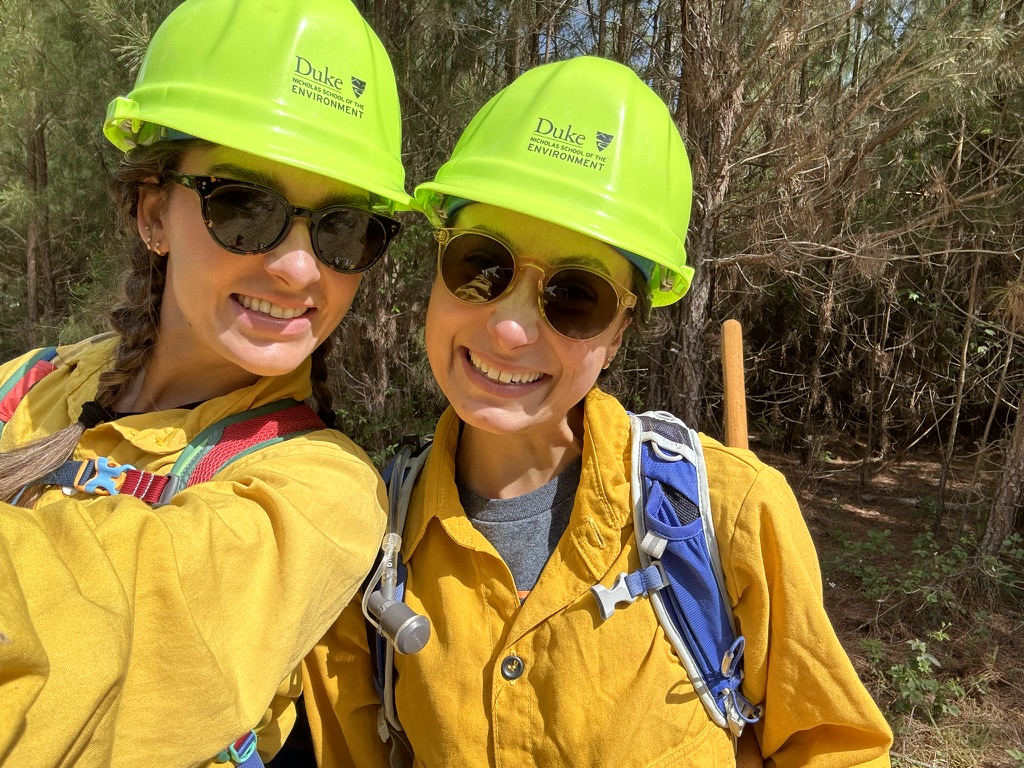by Jianna Torre Master of Forestry Student
In late April 2024, Duke Forest staff and Duke Nicholas School of the Environment Master of Forestry students completed a prescribed burn of a 30-acre hardwood tract in the Hillsboro Division of the Duke Forest. Prescribed fire (also called controlled burn) is a valuable tool for foresters in managing forests. Prescribed fire is used for a variety of different reasons: it can burn through coarse and fine woody debris and leaf litter on the forest floor (also called “fuels”) to reduce the risk of catastrophic wildfire, or it can be used to promote fire-adapted ecosystems such as oak-hickory forests. In the case of this 30-acre burn, the goal was the latter — burning through the understory of this hardwood forest will promote the regeneration and recruitment of species like oak and hickory rather than species like maple and tulip poplar. Managing for oak and hickory increases the diversity, and therefore the resilience, of the forest and provides habitat and a nutritious food source for wildlife, such as cavity nesting birds, bats, salamanders, deer, squirrels, snakes, and turtles, to name only a few.
Around 10 years ago, this stand was thinned through an “establishment cut,” the first step in a shelterwood regeneration method (Figure 1). The establishment cut involves harvesting a portion of the overstory to create favorable light conditions to enable establishment and regeneration of desired species in the understory. Eventually, once the new cohort of desired species has established underneath the residual overstory trees, the overstory is harvested through a “removal cut,” step two of the shelterwood method. The shelterwood method is often employed to promote the development of oak trees because the dappled light conditions created by the establishment cut provide the growing oaks with sufficient sun and partial shade, rather than full-on, direct sunlight. However, if a forest manager is trying to promote the regeneration of oaks — for the purpose of supporting wildlife, commercial use, or both — the shelterwood method is just one step in a longer process to create the conditions needed for the next generation of overstory oaks.
Figure 1: Diagram of the shelterwood regeneration method. Source: SFA Silviculture Textbook, Figure 3.4.3. Jeremey Stovall. 2024.

While the conditions for oak saplings to establish are better than before the shelterwood method’s establishment cut, it is likely that the oaks may still be out-competed by fast-growing, shade-intolerant species such as tulip poplar or loblolly pine. This was the case for the 30-acre tract in the Hillsboro division, and thus, a burn was prescribed to create conditions to further favor the growth of advanced oak regeneration. By moving low-intensity fire through the understory, the population of small-diameter tulip poplars will be significantly thinned or killed; however, fire-adapted species like oaks will survive. How do the small-diameter oaks and oak saplings survive the fire? Early on in their development, oaks allocate more of their energy to below-ground biomass (i.e., an extensive root system), while shade-intolerant species like tulip poplar spend the majority of their energy on vertical growth (i.e., if they can reach the canopy sooner, they will have the access to light they need). Thus, when fire burns through the understory, the oaks will have enough belowground development to quickly regrow foliage after the fire while the tulip poplars will not.
Before the burn, Duke Forest staff wrote a burn plan to establish the objectives of the burn, the range of appropriate weather conditions, as well as a safety and smoke management plan. Additionally, local fire crews were informed of the burn and fire lines were further cleared to ensure the absence of fuels. On the day of the burn, the crew met in the early morning to review the burn plan, crew member assignments, and safety briefing. Tom Craven, Forest Supervisor for the Office of the Duke Forest and the day’s burn boss, verified that the weather conditions (including relative humidity, temperature, windspeed, and wind direction) were all appropriate so that the crew could proceed with the burn. After the weather checks, Tom used the drip torch, a handheld tool often used to ignite prescribed burns (Figure 2), to ignite a test fire on the east side of the North Line (Figure 3). Once Tom and the crew determined the test burn was successful, the next step was to ignite the entirety of the North Line. The crew was implementing a backing fire, which is when the fire moves or “backs” into the wind. This ensures the fire doesn’t move rapidly with the wind, and allows the crew to have more control over the speed and intensity of the fire. On the day of the burn, the crew first lit the North and East Lines, in order to back into the winds coming from the southwest. The fire slowly moved from the northeast towards the southwest, and as it progressed, the crew lit the West Line. Throughout the day, the fire continued to slowly advance, sometimes petering out along the East Line due to the wetness of the streams in that area. In the early afternoon, once there was no more dry leaf material on the forest floor to burn through, the crew began the “mop up” process. The mop up involves walking the perimeter of the fire to douse any still smoldering large woody debris with water. Before, during, and after images from the fire can be seen in Figure 4.
Returning prescribed fire to fire-adapted ecosystems increases both the structural and species diversity of the forested landscape, which ultimately supports forest resiliency. Furthermore, oaks provide a tremendous food source and habitat for wildlife, including squirrels, birds, other small mammals, and bats. Fire also helps create snags (dead standing trees) and coarse woody debris, which are crucial habitats for insects, reptiles, and amphibians. Through regular, low-intensity prescribed fire regimes, forest managers can play a role in caring for and maintaining these highly valued ecosystems.
Figure 2: Maggie Heraty, Senior Program Coordinator for the Office of the Duke Forest, uses a drip torch to ignite the perimeter of the burn unit.

Figure 3: Map of the Duke Forest Hillsboro Division Burn Unit and surrounding areas. The red polygon represented the burn unit where the prescribed burn took place.

Figure 4: Before, during, and after photos from the burn. In the “before photo” (4a), the small-diameter tulip poplars that are out-competing the small-diameter oaks can be seen on the left-hand side of the photo. In the “during”’ photo (4b), the fire is slowly moving further into the interior of the burn unit. In the “after” photo (4c) taken ~3 months after the burn, regenerating oak saplings in the understory can be seen.



Figure 5: Sara Childs, Executive Director for the Office of the Duke Forest, walks the perimeter of the North Line to ensure there are no “spot-overs,” embers from the burn unit landing across the fire line.

Figure 6: Duke Master of Forestry students Brook Hemphill (left) & Jianna Torre (right) pictured in their prescribed fire safety equipment: flame-resistant clothing and hardhats.






